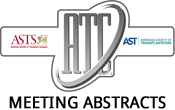2022 American Transplant Congress
Peripheral Blood Immune Cell Profiles of Corneal Transplant with and without Acute Rejection
*Purpose: Acute rejection (AR) of allogeneic corneal transplantation (CT) has a profound effect on subsequent graft survival, indicating that immunological damage is often not fully…2022 American Transplant Congress
Zfyve21 Activates T Cell Intrinsic, Nlrp3 Inflammasomes to Promote Allograft Vasculopathy
*Purpose: Allograft vasculopathy (AV) is a complication of chronic allograft rejection whose underlying mechanism(s) of etiopathogenesis are poorly defined. We examined the role of ZFYVE21,…2022 American Transplant Congress
Donor-Specific T Cell Senescence In Operationally Tolerant Liver Transplant Recipients
*Purpose: Recent evidence indicates a correlation in liver transplant recipients between successful operational tolerance (OT) post immunosuppression withdrawal (ISW) with both recipient age and time…2022 American Transplant Congress
Deficiency of Antibody-Suppressor CXCR5+CD8+ T Cells (Not CD4+ Tregs) Drive High Alloantibody Production in CCR5 KO Kidney Transplant Recipients
*Purpose: Kidney transplant (KTx) into CCR5 KO mice is an excellent model to study AMR immunobiology due to high alloantibody (alloAb) production, rapid allograft rejection,…2022 American Transplant Congress
Local Cognate Antigen in Kidney Allografts Promotes Tissue Resident Memory T Cell Maintenance
*Purpose: Our lab has demonstrated that tissue resident memory T cells (TRM cells) sustain chronic kidney allograft rejection in mice. It remains unknown how TRM…2022 American Transplant Congress
The Promise Of Tolerance In Living Donor Kidney Transplant (LDKT): A Retrospective, Real-world Assessment Of The Safety And Efficacy Of LDKT With FCR001 Investigational Cell-therapy Compared With Standard Of Care (SOC)
*Purpose: FCR001 (FCR) is a cell therapy derived from mobilized donor PBMCs including hematopoietic progenitor cells, facilitating cells, and αβ T cells, intended to establish…2021 American Transplant Congress
A Mechanistic Evaluation to Guide the Optimal Immunosuppression Adjustment Strategy in Transplant Patients with COVID-19
*Purpose: The optimal management of immunosuppression in transplant patients infected with COVID-19 is unknown. Reduction in calcineurin inhibitors or antimetabolite doses is often performed in…2021 American Transplant Congress
Enhancement of Regulatory T Cell Therapies by Biomimetic Nanofiber Matrices on Single Cells
*Purpose: Here we report a new method to create an artificial and biodegradable matrix of biomimetic nanofibers on single cells with the goal of enhancing…2021 American Transplant Congress
Nomogram of Quantity of Peripheral Cxcr5+Cd8+ T Cells, Aims to Predict Risk of De Novo Dsa in First-time Kidney Transplant Recipients
1OSU, Columbus, OH, 2Center for Biostatistics, OSU, Columbus, OH
*Purpose: We recently reported that peripheral CXCR5+CD8+ T cells are inversely associated with the risk of developing de novo DSA (dnDSA) in the first year…2021 American Transplant Congress
Effect of HLA Class II Polymorphism on Predicted Cellular Immunity Against SARS-CoV-2 at the Individual Level and Within Twenty Five Race/ethnic Groups
*Purpose: Development of adaptive immunity after COVID-19 and after vaccination against SARS-CoV-2 is predicated on recognition of viral peptides, presented on HLA class II molecules,…
- « Previous Page
- 1
- …
- 6
- 7
- 8
- 9
- 10
- …
- 53
- Next Page »
